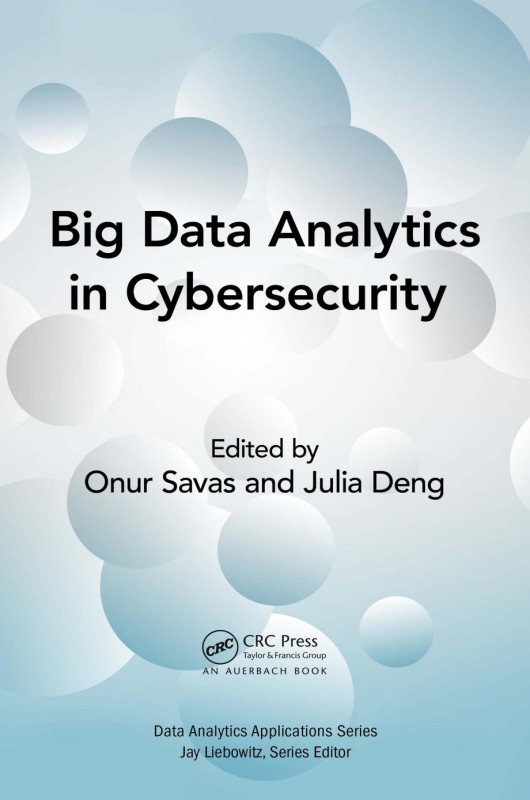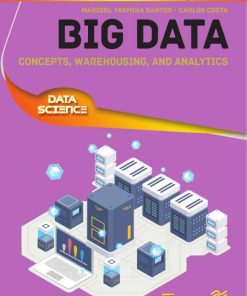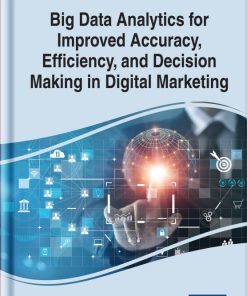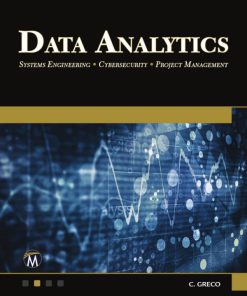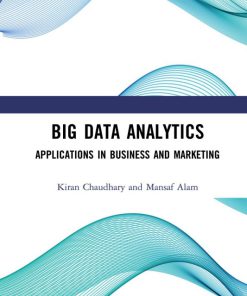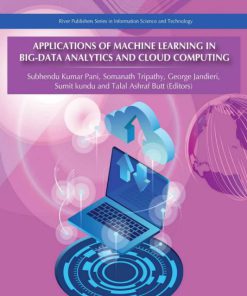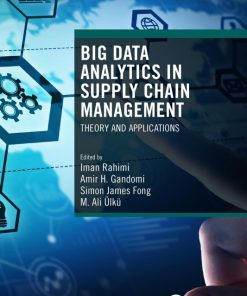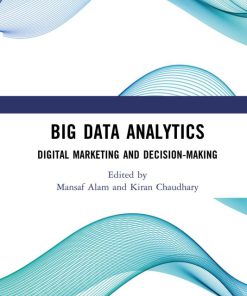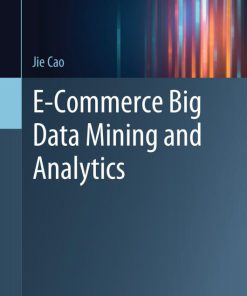Big Data Analytics in Cybersecurity 1st Edition by Onur Savas ISBN 1351650416 9781351650410
$50.00 Original price was: $50.00.$25.00Current price is: $25.00.
Authors:Onur Savas; Julia Deng , Series:Cyber Security [41] , Tags:Business & Economics; Statistics; Computers; Information Technology; Security; General; Reference; Yearbooks & Annuals , Author sort:Savas, Onur & Deng, Julia , Ids:Google; 9781498772167 , Languages:Languages:eng , Published:Published:Sep 2017 , Publisher:CRC Press , Comments:Comments:Big data is presenting challenges to cybersecurity. For an example, the Internet of Things (IoT) will reportedly soon generate a staggering 400 zettabytes (ZB) of data a year. Self-driving cars are predicted to churn out 4000 GB of data per hour of driving. Big data analytics, as an emerging analytical technology, offers the capability to collect, store, process, and visualize these vast amounts of data. Big Data Analytics in Cybersecurity examines security challenges surrounding big data and provides actionable insights that can be used to improve the current practices of network operators and administrators. Applying big data analytics in cybersecurity is critical. By exploiting data from the networks and computers, analysts can discover useful network information from data. Decision makers can make more informative decisions by using this analysis, including what actions need to be performed, and improvement recommendations to policies, guidelines, procedures, tools, and other aspects of the network processes. Bringing together experts from academia, government laboratories, and industry, the book provides insight to both new and more experienced security professionals, as well as data analytics professionals who have varying levels of cybersecurity expertise. It covers a wide range of topics in cybersecurity, which include: Network forensics Threat analysis Vulnerability assessment Visualization Cyber training. In addition, emerging security domains such as the IoT, cloud computing, fog computing, mobile computing, and cyber-social networks are examined. The book first focuses on how big data analytics can be used in different aspects of cybersecurity including network forensics, root-cause analysis, and security training. Next it discusses big data challenges and solutions in such emerging cybersecurity domains as fog computing, IoT, and mobile app security. The book concludes by presenting the tools and datasets for future cybersecurity research.
Big Data Analytics in Cybersecurity 1st Edition by Onur Savas – Ebook PDF Instant Download/Delivery. 1351650416, 9781351650410
Full download Big Data Analytics in Cybersecurity 1st Edition after payment
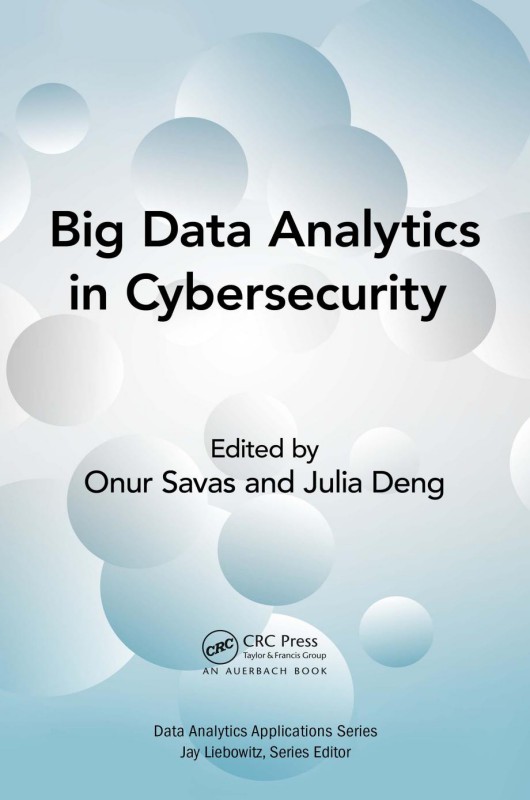
Product details:
ISBN 10: 1351650416
ISBN 13: 9781351650410
Author: Onur Savas
Big data is presenting challenges to cybersecurity. For an example, the Internet of Things (IoT) will reportedly soon generate a staggering 400 zettabytes (ZB) of data a year. Self-driving cars are predicted to churn out 4000 GB of data per hour of driving. Big data analytics, as an emerging analytical technology, offers the capability to collect, store, process, and visualize these vast amounts of data. Big Data Analytics in Cybersecurity examines security challenges surrounding big data and provides actionable insights that can be used to improve the current practices of network operators and administrators. Applying big data analytics in cybersecurity is critical. By exploiting data from the networks and computers, analysts can discover useful network information from data. Decision makers can make more informative decisions by using this analysis, including what actions need to be performed, and improvement recommendations to policies, guidelines, procedures, tools, and other aspects of the network processes. Bringing together experts from academia, government laboratories, and industry, the book provides insight to both new and more experienced security professionals, as well as data analytics professionals who have varying levels of cybersecurity expertise. It covers a wide range of topics in cybersecurity, which include: Network forensics Threat analysis Vulnerability assessment Visualization Cyber training. In addition, emerging security domains such as the IoT, cloud computing, fog computing, mobile computing, and cyber-social networks are examined. The book first focuses on how big data analytics can be used in different aspects of cybersecurity including network forensics, root-cause analysis, and security training. Next it discusses big data challenges and solutions in such emerging cybersecurity domains as fog computing, IoT, and mobile app security. The book concludes by presenting the tools and datasets for future cybersecurity research.
Big Data Analytics in Cybersecurity 1st Table of contents:
Section I Applying Big Data into Different Cybersecurity Aspects
Chapter 1 The Power of Big Data in Cybersecurity
1.1 Introduction to Big Data Analytics
1.1.1 What Is Big Data Analytics?
1.1.2 Differences between Traditional Analytics and Big Data Analytics
1.1.2.1 Distributed Storage
1.1.2.2 Support for Unstructured Data
1.1.2.3 Fast Data Processing
1.1.3 Big Data Ecosystem
1.2 The Need for Big Data Analytics in Cybersecurity
1.2.1 Limitations of Traditional Security Mechanisms
1.2.2 The Evolving Threat Landscape Requires New Security Approaches
1.2.3 Big Data Analytics Offers New Opportunities to Cybersecurity
1.3 Applying Big Data Analytics in Cybersecurity
1.3.1 The Category of Current Solutions
1.3.2 Big Data Security Analytics Architecture
1.3.3 Use Cases
1.3.3.1 Data Retention/Access
1.3.3.2 Context Enrichment
1.3.3.3 Anomaly Detection
1.4 Challenges to Big Data Analytics for Cybersecurity
References
Chapter 2 Big Data for Network Forensics
2.1 Introduction to Network Forensics
2.2 Network Forensics: Terms and Process
2.2.1 Terms
2.2.2 Network Forensics Process
2.2.2.1 Phase 1: Data Collection
2.2.2.2 Phase 2: Data Examination
2.2.2.3 Phase 3: Data Analysis
2.2.2.4 Phase 4: Visualization and Reporting
2.3 Network Forensics: Current Practice
2.3.1 Data Sources for Network Forensics
2.3.2 Most Popular Network Forensic Tools
2.3.2.1 Packet Capture Tools
2.3.2.2 Flow Capture and Analysis Tools
2.3.2.3 Intrusion Detection System
2.3.2.4 Network Monitoring and Management Tools
2.3.2.5 Limitations of Traditional Technologies
2.4 Applying Big Data Analysis for Network Forensics
2.4.1 Available Big Data Software Tools
2.4.1.1 Programming Model: MapReduce
2.4.1.2 Compute Engine: Spark, Hadoop
2.4.1.3 Resource Manager: Yarn, Mesos
2.4.1.4 Stream Processing: Storm, Spark Streaming, Apache Flink, Beam
2.4.1.5 Real-Time In-Memory Processing: Apache Ignite, Hazelcast
2.4.1.6 Fast SQL Analytics (OLAP): Apache Drill, Kylin
2.4.1.7 NOSQL (Non-Relational) Databases: HBase, Accumulo, MongoDB, Cassandra, Voldmort
2.4.1.8 NOSQL Query Engine: Pheonix, Pig
2.4.2 Design Considerations
2.4.2.1 NOSQL Databases
2.4.2.2 Computing Frameworks
2.4.3 State-of-the-Art Big Data Based Cyber Analysis Solutions
2.4.3.1 Cisco OpenSOC
2.4.3.2 Sqrrl Enterprise
2.5 Our Experiences
2.5.1 Software Architecture
2.5.2 Services Components
2.5.2.1 Data Processing Using Accumulo
2.5.2.2 Log Service (Message System) Using Kafka
2.5.2.3 Stream Processing Engine Using Storm
2.5.3 Key Features
2.6 Summary
References
Chapter 3 Dynamic Analytics-Driven Assessment of Vulnerabilities and Exploitation
3.1 Introduction
3.1.1 The Need and Challenges
3.1.2 The Objective and Approach of This Chapter
3.2 Vulnerability Assessment, Attribution, and Exploitation
3.2.1 Vulnerability Assessment
3.2.2 Use Case: Identification and Attribution of Vulnerability Exploitation
3.3 State-of-the-Art Vulnerability Assessment Tools, Data Sources, and Analytics
3.3.1 Vulnerability Assessment Tools
3.3.2 Data Sources, Assessment, and Parsing Methods
3.4 Secure Management of Cyber Events Involved with Vulnerability and Exploitation
3.4.1 Comparison of Current SIEM Tools
3.4.1.1 Open Source SIEM Tools
3.4.1.2 Traditional SIEM Tool
3.4.1.3 Non-Traditional SIEM Tool
3.4.2 Temporal Causality Analysis for Enhancing Management of Cyber Events
3.5 Summary and Future Directions
References
Chapter 4 Root Cause Analysis for Cybersecurity
4.1 Introduction
4.2 Root Cause Analysis and Attack Attribution
4.3 The Causal Analysis of Security Threats
4.3.1 Challenges in Detecting Security Incidents
4.3.2 Root Cause Analysis for Security Data Mining
4.3.2.1 Feature Selection for Security Events
4.3.2.2 Graph-Based Clustering
4.3.2.3 MCDA-Based Attack Attribution
4.4 Case Studies
4.4.1 Attack Attribution via Multi-Criteria Decision Making
4.4.1.1 Defining Attack Characteristics
4.4.1.2 Extracting Cliques of Attackers
4.4.1.3 Multi-Criteria Decision Making
4.4.2 Large-Scale Log Analysis for Detecting Suspicious Activity
4.4.2.1 Defining Attack Characteristics
4.4.2.2 Discovering Outliers in the Network
4.5 Conclusion
References
Chapter 5 Data Visualization for Cybersecurity
5.1 Introduction
5.2 Threat Identification, Analysis, and Mitigation
5.3 Vulnerability Management
5.4 Forensics
5.5 Traffic
5.6 Emerging Themes
References
Chapter 6 Cybersecurity Training
6.1 Specific Characteristics of Training Cybersecurity
6.2 General Principles of Training and Learning
6.2.1 Desired Result of Training: Better Performance
6.2.2 Use of Media in Training
6.2.3 Context in which to Present General Learning Principles
6.2.4 Learning with Understanding
6.2.5 Reflection and Interactions
6.2.6 Immersive Environments of Simulations and Games
6.2.7 Building on What Learners Know
6.2.8 Metacognition
6.2.9 Teamwork
6.2.10 Feedback
6.2.11 Motivation
6.2.12 Transfer
6.2.13 Misconceptions
6.3 Practical Design
6.3.1 Sponsor’s Expectations
6.3.2 Available Resources
6.3.3 Subject Matter Experts and Cognitive Task Analysis
6.3.4 Identify What Trainees Need To Learn
6.3.5 The Underlying Representation That Supports Computerized Assessment and Instruction
6.3.6 Pilot Test the Instruction
6.4 Putting it All Together
6.5 Using Big Data to Inform Cybersecurity Training
6.6 Conclusions
References
Chapter 7 Machine Unlearning: Repairing Learning Models in Adversarial Environments
7.1 Introduction
7.1.1 The Need for Systems to Forget
7.1.2 Machine Unlearning
7.1.3 Chapter Organization
7.2 Background and Adversarial Model
7.2.1 Machine Learning Background
7.2.2 Adversarial Model
7.2.2.1 System Inference Attacks
7.2.2.2 Training Data Pollution Attacks
7.3 Overview
7.3.1 Unlearning Goals
7.3.1.1 Completeness
7.3.1.2 Timeliness
7.3.2 Unlearning Work Flow
7.4 Unlearning Approach
7.4.1 Nonadaptive SQ Learning
7.4.2 Adaptive SQ Learning
7.5 Unlearning in LensKit
7.5.1 The Attack–System Inference
7.5.2 Analytical Results
7.5.3 Empirical Results
7.6 Related Work
7.6.1 Adversarial Machine Learning
7.6.1.1 Causative Attacks
7.6.1.2 Exploratory Attacks
7.6.2 Defense of Data Pollution and Privacy Leakage
7.6.2.1 Defense of Data Pollution
7.6.2.2 Defense of Privacy Leaks
7.6.3 Incremental Machine Learning
Further Reading
References
Section II Big Data in Emerging Cybersecurity Domains
Chapter 8 Big Data Analytics for Mobile App Security
8.1 Introduction to Mobile App Security Analysis
8.2 Applying Machine Learning (ML) in Triaging App Security Analysis
8.3 The State-of-the-Art ML Approaches for Android Malware Detection
8.4 Challenges in Applying ML for Android Malware Detection
8.4.1 Challenges in Ensuring Proper Evaluation
8.4.2 Challenges in the Algorithm Design
8.4.3 Challenges in Data Collection
8.4.4 Insights Based on Our Own Study
8.5 Recommendations
8.5.1 Data Preparation and Labeling
8.5.2 Learning from Large Data
8.5.3 Imbalanced Data
8.5.4 Expensive Features
8.5.5 Leveraging Static Analysis in Feature Selection
8.5.6 Understanding the Results
8.6 Summary
References
Chapter 9 Security, Privacy, and Trust in Cloud Computing
9.1 Introduction to Cloud
9.1.1 Deployment Models
9.1.2 Service Models
9.1.3 Distinct Characteristics
9.1.4 Key Technologies
9.2 Security, Privacy, and Trust Challenges in Cloud Computing
9.2.1 Security Attacks against Multi-Tenancy
9.2.2 Security Attacks against Virtualization
9.2.3 Data Security and Privacy in Cloud
9.2.4 Lack of Trust among Multiple Stakeholders in Cloud
9.3 Security, Privacy, and Trust Solutions in Cloud Computing
9.3.1 Logging and Monitoring
9.3.2 Access Control
9.3.3 Encryption-Based Security Solutions
9.3.4 Virtual Isolation
9.3.5 Defense against Co-Resident Attacks
9.3.6 Establishing Trust in Cloud Computing
9.4 Future Directions
9.5 Conclusion
References
Chapter 10 Cybersecurity in Internet of Things (IoT)
10.1 Introduction
10.2 IoT and Big Data
10.3 Security Requirement and Issues
10.3.1 Heterogeneous Big Data Security and Management
10.3.2 Lightweight Cryptography
10.3.3 Universal Security Infrastructure
10.3.4 Trust Management
10.3.5 Key Management
10.3.6 Privacy Preservation
10.3.6.1 Identity Privacy
10.3.6.2 Location Privacy
10.3.6.3 Profiling Privacy
10.3.6.4 Linkage Privacy
10.3.6.5 Interaction Privacy
10.3.7 Transparency
10.3.8 Fraud Protection
10.3.8.1 Ad Fraud
10.3.8.2 ATM Fraud
10.3.8.3 NTL Fraud
10.3.9 Identity Management
10.3.9.1 Identity and Address
10.3.9.2 Identity and Ownership
10.3.9.3 Identity and Domain
10.3.9.4 Identity and Lifecycle
10.4 Big Data Analytics for Cybersecurity in IoT
10.4.1 Single Big Dataset Security Analysis
10.4.2 Big Amount of Datasets Security Analysis
10.4.3 Big Heterogeneous Security Data
10.4.3.1 Heterogeneous Input Data
10.4.3.2 Heterogeneous Output Data
10.4.4 Information Correlation and Data Fusion
10.4.5 Dynamic Security Feature Selection
10.4.6 Cross-Boundary Intelligence
10.5 Conclusion
References
Chapter 11 Big Data Analytics for Security in Fog Computing
11.1 Introduction
11.2 Background of Fog Computing
11.2.1 Definitions
11.2.2 Features
11.2.3 Architectures and Existing Implementations
11.2.4 The State-of-the-Art of Data Analytics in Fog Computing
11.3 When Big Data Meets Fog Computing
11.4 Big Data Analytics for Fog Computing Security
11.4.1 Trust Management
11.4.2 Identity and Access Management
11.4.3 Availability Management
11.4.4 Security Information and Event Management
11.4.5 Data Protection
11.5 Conclusion
References
Chapter 12 Analyzing Deviant Socio-Technical Behaviors Using Social Network Analysis and Cyber Forensics-Based Methodologies
12.1 Introduction
12.2 Literature Review
12.3 Methodology
12.4 Case Studies
12.4.1 DAESH or ISIS/ISIL Case Study: Motivation, Evolution, and Findings
12.4.1.1 Exploring the Network of the Top Disseminators of ISIL
12.4.1.2 Beheading of Innocent People by ISIL
12.4.2 Novorossiya Case Study: Motivation, Evolution, and Findings
12.5 Conclusion and Future Work
Acknowledgments
References
Section III Tools and Datasets for Cybersecurity
Chapter 13 Security Tools
13.1 Introduction
13.2 Defining Areas of Personal Cybersecurity
13.3 Tools for Big Data Analytics
13.4 Boundary Tools
13.4.1 Firewalls
13.4.1.1 ISP Firewalls
13.4.1.2 Home Firewalls
13.4.1.3 Free Software Firewalls
13.4.2 Antivirus
13.4.3 Content Filtering
13.5 Network Monitoring Tools
13.6 Memory Protection Tools
13.7 Memory Forensics Tools
13.8 Password Management
13.9 Conclusion
Chapter 14 Data and Research Initiatives for Cybersecurity Analysis
14.1 Cybersecurity Data Sources
14.1.1 Datasets from the Operating System
14.1.2 Datasets from Network Traffic
14.1.3 Datasets from the Application Layer
14.2 Benchmark Datasets
14.2.1 DARPA KDD Cup Dataset
14.2.1.1 Website
14.2.1.2 Short Description
14.2.2 CDX 2009 Dataset
14.2.2.1 Website
14.2.2.2 Short Description
14.2.3 UNB ISCX 2012
14.2.3.1 Website
14.2.3.2 Short Description
14.3 Research Repositories and Data Collection Sites
14.3.1 IMPACT (The Information Marketplace for Policy and Analysis of Cyber-Risk & Trust)
14.3.1.1 Website
14.3.1.2 Short Description
14.3.1.3 Example Datasets
14.3.2 CAIDA (The Center for Applied Internet Data Analysis)
14.3.2.1 Website
14.3.2.2 Short Description
14.3.2.3 Example Datasets
14.3.3 Publicly Available PCAP Repository Collections—netresec.com
14.3.3.1 Website
14.3.3.2 Short Description
14.3.3.3 Example Datasets
14.3.4 Publicly Available Repository Collections—SecRepo.com
14.3.4.1 Website
14.3.4.2 Short Description
14.3.4.3 Example Datasets
14.4 Future Directions on Data Sharing
People also search for Big Data Analytics in Cybersecurity 1st:
big data analytics in cybersecurity
what is intelligent data analysis in big data
big data analytics examples
what is data analytics in big data
big data vs cyber security

